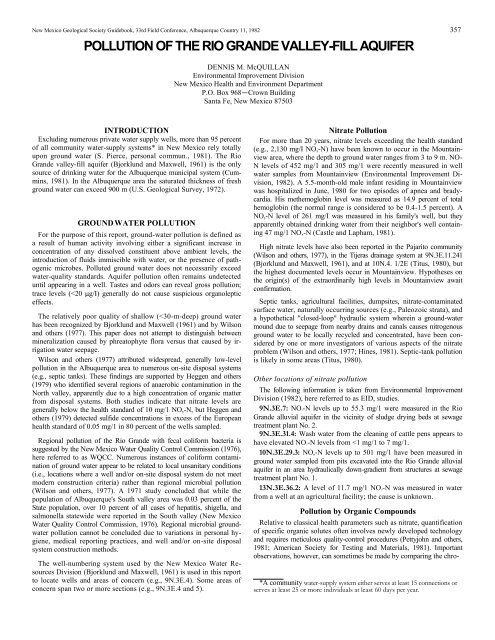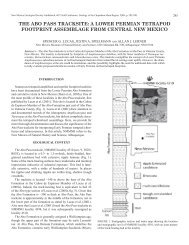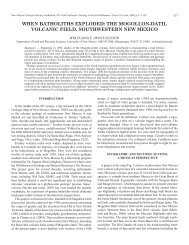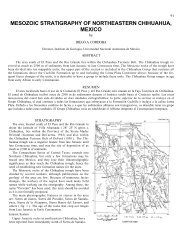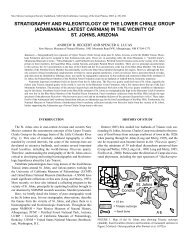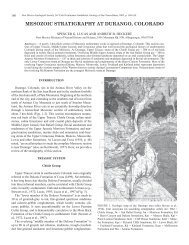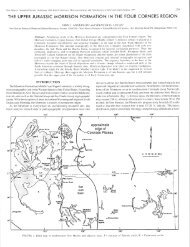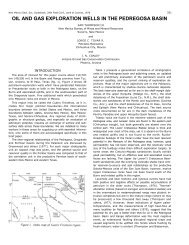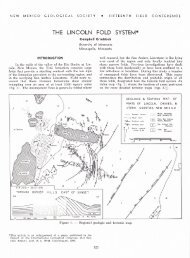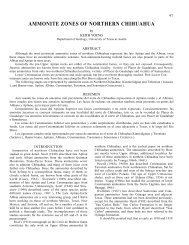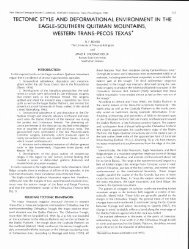Pollution of the Rio Grande Valley-fill aquifer - New Mexico ...
Pollution of the Rio Grande Valley-fill aquifer - New Mexico ...
Pollution of the Rio Grande Valley-fill aquifer - New Mexico ...
Create successful ePaper yourself
Turn your PDF publications into a flip-book with our unique Google optimized e-Paper software.
<strong>New</strong> <strong>Mexico</strong> Geological Society Guidebook, 33rd Field Conference, Albuquerque Country 11, 1982 357<br />
POLLUTION OF THE RIO GRANDE VALLEY-FILL AQUIFER<br />
INTRODUCTION<br />
Excluding numerous private water supply wells, more than 95 percent<br />
<strong>of</strong> all community water-supply systems* in <strong>New</strong> <strong>Mexico</strong> rely totally<br />
upon ground water (S. Pierce, personal commun., 1981). The <strong>Rio</strong><br />
<strong>Grande</strong> valley-<strong>fill</strong> <strong>aquifer</strong> (Bjorklund and Maxwell, 1961) is <strong>the</strong> only<br />
source <strong>of</strong> drinking water for <strong>the</strong> Albuquerque municipal system (Cummins,<br />
1981). In <strong>the</strong> Albuquerque area <strong>the</strong> saturated thickness <strong>of</strong> fresh<br />
ground water can exceed 900 m (U.S. Geological Survey, 1972).<br />
GROUND-WATER POLLUTION<br />
For <strong>the</strong> purpose <strong>of</strong> this report, ground-water pollution is defined as<br />
a result <strong>of</strong> human activity involving ei<strong>the</strong>r a significant increase in<br />
concentration <strong>of</strong> any dissolved constituent above ambient levels, <strong>the</strong><br />
introduction <strong>of</strong> fluids immiscible with water, or <strong>the</strong> presence <strong>of</strong> pathogenic<br />
microbes. Polluted ground water does not necessarily exceed<br />
water-quality standards. Aquifer pollution <strong>of</strong>ten remains undetected<br />
until appearing in a well. Tastes and odors can reveal gross pollution;<br />
trace levels (
358 McQUILLAN<br />
matographic signals <strong>of</strong> complex samples without identifying each specific<br />
organic compound. In a presentation <strong>of</strong> methods for estimating<br />
<strong>the</strong> number <strong>of</strong> unseen (but potentially observable) organic pollutants in<br />
<strong>the</strong> aquatic environment, Janardan and Schaeffer (1981) point out that<br />
in general, for a complex water sample containing a large number <strong>of</strong><br />
distinct compounds, only a fraction <strong>of</strong> <strong>the</strong> compounds potentially identifiable<br />
by a given method are actually identified. When an organic<br />
compound is detected in a water sample, two key questions must be<br />
asked.<br />
1. Is that compound a true water-sample contaminant? Laboratory<br />
contamination is troublesome particularly with dichloromethane. Gas<br />
chromatograph-mass spectrometer (GCMS) analyses produce several<br />
"best fits" <strong>of</strong> <strong>the</strong> signal <strong>of</strong> a sample contaminant with <strong>the</strong> signals <strong>of</strong><br />
compounds in <strong>the</strong> analyst's computer library. Millions <strong>of</strong> organic chemicals<br />
have been identified, but GCMS libraries, such as that used by<br />
<strong>the</strong> <strong>New</strong> <strong>Mexico</strong> Scientific Laboratory Division, contain data for about<br />
32,000 chemicals. The presence in water, within <strong>the</strong> limits <strong>of</strong> detection,<br />
<strong>of</strong> common organics such as benzene is relatively easily confirmed. A<br />
GCMS computer <strong>of</strong>ten identifies ra<strong>the</strong>r exotic contaminants for which<br />
standards are not readily available; some degree <strong>of</strong> analytical misidentification<br />
is probably unavailable.<br />
2. Is that compound a true water-source contaminant? Improperly<br />
cleaned sample vessels and improper sampling procedures may cause<br />
sample contamination. Contaminants not present in a water source (e.g.,<br />
an <strong>aquifer</strong>) can be introduced by such features as plumbing materials.<br />
The loss <strong>of</strong> water-source contaminants must also be considered. The<br />
quantity <strong>of</strong> volatile organics lost by outgassing, for example, can greatly<br />
depend on sample extraction methods (e.g., a suction lift pump versus<br />
a bailing device that preserves in-situ hydrostatic pressure).<br />
Hydrocarbon fuel oils such as gasoline and diesel and many one- or<br />
two-carbon polychlorinated compounds are somewhat mobile in <strong>the</strong><br />
subsurface and are quite capable <strong>of</strong> polluting ground water (American<br />
Petroleum Institute, 1980; Council on Environmental Quality, 1981).<br />
Steel underground storage tanks have a reputation <strong>of</strong> leaking gasoline;<br />
fiberglass tanks are now commonly used. Some companies, such as<br />
Chevron U.S.A., Inc., are undertaking commendable programs <strong>of</strong> pressure<br />
testing tanks to identify and resolve potential problems.<br />
Locations <strong>of</strong> organic-compound pollution<br />
The following locations are summarized from Environmental Improvement<br />
Division (1982) research.<br />
4N.2E.29: This site is located immediately northwest <strong>of</strong> <strong>the</strong> intersection<br />
<strong>of</strong> N.M. State Roads 47 and 346. Ground water sampled from<br />
pits excavated into <strong>the</strong> water table next to a now inoperative gas station<br />
was reportedly polluted with gasoline.<br />
5N.2E.18.4: Diesel-fueling operations have been conducted at this<br />
site since <strong>the</strong> early 1950's. Efforts to control fuel spillage include <strong>the</strong><br />
installation during 1970-72 <strong>of</strong> fuel nozzles with automatic shut <strong>of</strong>f<br />
feature to prevent tank overflow and <strong>the</strong> installation in 1978 <strong>of</strong> spill<br />
collector pans. The 2-3 m deep water table has been polluted with fuel<br />
at least since 1975. Several private domestic wells have been impacted.<br />
A trench —100 m long was dug to —0.5 m below <strong>the</strong> water table. The<br />
trench was back<strong>fill</strong>ed with gravel. A vertical, —1-m-diameter perforated<br />
pipe is located midway in <strong>the</strong> trench. A pump removing oil from <strong>the</strong><br />
water surface began operating in January, 1980 and has recovered more<br />
than 400,000 1 (liters) <strong>of</strong> diesel fuel. Polychlorinated biphenyls (PCBs;<br />
60 percent Cl) at
POLLUTION 359<br />
wells in <strong>the</strong> area (e.g., San Jose No. 6 in Table 1) were shut down<br />
after <strong>the</strong> detection <strong>of</strong> several volatile contaminants <strong>of</strong> health concern.<br />
One city well was put back to use in 1981 after subsequent analyses<br />
did not detect volatile organics.<br />
The EID is conducting a drilling and monitoring program funded by<br />
<strong>the</strong> U.S. Environmental Protection Agency to determine <strong>the</strong> source(s)<br />
and extent <strong>of</strong> pollution. The study area as described and mapped by<br />
Lambert (1968) extends eastward from floodplain alluvium through<br />
alluvial-fan and fan-apron deposits along <strong>the</strong> inner-valley margin and<br />
into <strong>the</strong> Upper Buff formation <strong>of</strong> <strong>the</strong> Santa Fe Group; <strong>the</strong> depth to<br />
ground water in <strong>the</strong> area <strong>of</strong> known pollution ranges from —6 to 29 m.<br />
This is a prototype study for <strong>the</strong> EID. Several monitoring techniques<br />
(described below) are being tested in this study. Locating vadose-zone<br />
pollution is very important for identifying <strong>the</strong> source(s) unless contaminants<br />
were injected into <strong>the</strong> <strong>aquifer</strong> (e.g., by means <strong>of</strong> inadvertent<br />
backflow siphonage into a well). Vadose-zone soil samples are collected<br />
in oblong glass chambers, with teflon stopcocks on each end, from<br />
which gases are purged for volatile organics GCMS analysis. To reduce<br />
<strong>the</strong> chances <strong>of</strong> introducing organic contaminants during well installation,<br />
stainless-steel well screens are driven below <strong>the</strong> drill bit <strong>of</strong> a<br />
hollow-stem auger. Samples are extracted with a bailer.<br />
An inventory <strong>of</strong> potential sources reveals that many organic compounds,<br />
sometimes accompanied by acids and bases, have entered <strong>the</strong><br />
subsurface at one or more facilities in <strong>the</strong> area. Some wastes were<br />
exposed to ultraviolet light (i.e., sunlight) before entering <strong>the</strong> subsurface.<br />
The question <strong>of</strong> whe<strong>the</strong>r biochemical- or physicochemical-pollutant<br />
transformations have occurred must be considered. It is well<br />
estabished that some organic pollutants are anaerobically biodegradable<br />
in soil and/or ground water (Leenheer and o<strong>the</strong>rs, 1976; Witt and<br />
McKinney, 1981; Sykes and o<strong>the</strong>rs, 1982). Kobayashi and Rittmann<br />
(1982) present evidence that many organics <strong>of</strong> health concern can be<br />
attacked by microbes (e.g., soil bacteria). McConnell and o<strong>the</strong>rs (1975)<br />
report <strong>the</strong> dehydrochlorination <strong>of</strong> 1,1,1-trichloroethane in sea water.<br />
Results <strong>of</strong> <strong>the</strong> EID study strongly suggest multiple pollution sources.<br />
Diesel fuel floating on water, but no chlorinated compounds, were<br />
detected in analyses <strong>of</strong> sediment, water, and oil at depths <strong>of</strong> —5-6 m<br />
at 10N.3E.32.4143. The sources(s) <strong>of</strong> <strong>the</strong> chlorinated aliphatics in San<br />
Jose well No. 6, which is reported to be >270 m deep, remain undetermined.<br />
Regulatory efforts are underway to control discharges <strong>of</strong><br />
organic contaminants in <strong>the</strong> study area.<br />
11N.3E.10.41 and 43: In November, 1981 a well driller reported<br />
gasoline contamination <strong>of</strong> a well penetrating a 6-m-deep water table.<br />
Additionally, Wilson and o<strong>the</strong>rs (1979) report a well at an ice plant<br />
being contaminated by a leaking tank at a gas station at an undisclosed<br />
location in Albuquerque. It is not known whe<strong>the</strong>r this case is <strong>the</strong> same<br />
as one <strong>of</strong> those described above.<br />
HEALTH EFFECTS AND REGULATIONS<br />
Ground-water quality regulations authorized by <strong>the</strong> <strong>New</strong> <strong>Mexico</strong><br />
Water Quality Act became effective in 1977. The purpose <strong>of</strong> <strong>the</strong>se<br />
regulations controlling discharges onto or below <strong>the</strong> surface <strong>of</strong> <strong>the</strong><br />
ground is to protect all ground water <strong>of</strong> <strong>the</strong> State <strong>of</strong> <strong>New</strong> <strong>Mexico</strong> which<br />
has an existing concentration <strong>of</strong> 10,000 mg/1 or less total dissolved<br />
solids, for present and potential future use as domestic and agricultural<br />
water supply, and to protect those segments <strong>of</strong> surface waters which<br />
are gaining because <strong>of</strong> ground-water inflow, for uses designated in <strong>the</strong><br />
<strong>New</strong> <strong>Mexico</strong> Water Quality Standards (<strong>New</strong> <strong>Mexico</strong> Water Quality<br />
Control Commission, 1982).<br />
Nitratet<br />
Two potential health hazards are related to <strong>the</strong> consumption <strong>of</strong> water<br />
containing large concentrations <strong>of</strong> nitrate (or nitrite): (1) induction <strong>of</strong><br />
me<strong>the</strong>moglobinemia, particularly in infants, and (2) potential formation<br />
<strong>of</strong> carcinogenic nitrosamines. Nitrate toxicity occurs as a result <strong>of</strong> its<br />
reduction to nitrite. A series <strong>of</strong> steps is involved by which nitrate present<br />
in water or food is converted by bacterial action to nitrite. This process<br />
can take place prior to ingestion, in <strong>the</strong> salivary glands, or in <strong>the</strong><br />
stomach.<br />
Nitrite acts in <strong>the</strong> blood to oxidize hemoglobin (<strong>the</strong> oxygen-carrying<br />
molecule) to me<strong>the</strong>moglobin, which does not provide oxygen to <strong>the</strong><br />
tissues. In severe cases <strong>the</strong> victim's nailbeds and lips are cyanotic.<br />
Healthy adults are reported to be able to consume large quantities <strong>of</strong><br />
nitrate in drinking water without developing me<strong>the</strong>moglobinemia, which<br />
is almost always seen in infants ra<strong>the</strong>r than adults. This increased<br />
susceptibility <strong>of</strong> infants has been attributed to high intake per unit<br />
weight, to <strong>the</strong> presence <strong>of</strong> nitrate-reducing bacteria in <strong>the</strong> upper gastrointestinal<br />
tract, to <strong>the</strong> condition <strong>of</strong> <strong>the</strong> mucosa, and to greater ease<br />
<strong>of</strong> oxidation <strong>of</strong> fetal hemoglobin. Gastric pH greater than 4 is conducive<br />
to <strong>the</strong> growth <strong>of</strong> nitrate-reducing bacteria. Such gastric conditions are<br />
likely to occur with infants, who are prone to upset stomachs and<br />
achlorhydria. From <strong>the</strong> viewpoint <strong>of</strong> induction <strong>of</strong> me<strong>the</strong>moglobinemia,<br />
<strong>the</strong> maximum concentration <strong>of</strong> nitrate in water exhibiting no observed<br />
adverse health effects is close to <strong>the</strong> standard <strong>of</strong> 10 mg/1 as nitrogen,<br />
established by <strong>the</strong> WQCC.<br />
The o<strong>the</strong>r health hazard associated with nitrate in drinking water,<br />
that it may act as a procarcinogen, is much more speculative. Following<br />
<strong>the</strong> conversion or nitrate to nitrite, <strong>the</strong> nitrite can <strong>the</strong>n react with o<strong>the</strong>r<br />
substances, such as amines, to form N-nitroso compounds. Most Nnitroso<br />
compounds are carcinogenic at high doses in animal tests. There<br />
is some evidence to support <strong>the</strong> possible etiologic role <strong>of</strong> nitrates in <strong>the</strong><br />
development <strong>of</strong> gastric and esophageal cancer; however, this relationship<br />
is undocumented at present. There is no apparent association between<br />
dietary nitrates and o<strong>the</strong>r cancers.<br />
Organic Compounds<br />
Most <strong>of</strong> <strong>the</strong> numerical standards adopted by <strong>the</strong> WQCC for organic<br />
ground-water contaminants were developed based upon cancer risks<br />
which would result from drinking polluted ground water over a long<br />
period <strong>of</strong> tme. WQCC regulations also contain a narrative definition<br />
<strong>of</strong> "toxic pollutant" which includes a list <strong>of</strong> >70 organic compounds<br />
identified as "potential" toxic pollutants. A potential toxic pollutant<br />
becomes a toxic pollutant if it causes, for example, an additional lifetime<br />
cancer risk greater than one additional cancer per 100,000 exposed<br />
persons.<br />
Human toxicological data for benzene are relatively good. Benzene<br />
has been causally linked to leukemia, aplastic anemia, and o<strong>the</strong>r conditions<br />
<strong>of</strong> <strong>the</strong> blood and bone marrow in humans. The WQCC groundwater<br />
standard <strong>of</strong> 10 p,g/1 represents a lifetime carcinogenic risk <strong>of</strong><br />
about one additional cancer per 100,000 exposed persons (Zalma, 1981).<br />
Due to <strong>the</strong> absence <strong>of</strong> any literature supportive <strong>of</strong> any carcinogenicity<br />
<strong>of</strong> pure toluene, <strong>the</strong> WQCC ground-water standard <strong>of</strong> 15 mg/1 is based<br />
upon noncarcinogenic toxicity considerations (Zalma, 1981). There is<br />
some evidence that toluene at very high doses causes increased chromosome<br />
breaks in rats, but more studies need to be done (Puck, 1981).<br />
The WQCC ground-water standard <strong>of</strong> I lig/1 <strong>of</strong> PCBs is based upon<br />
carcinogenic risks, from <strong>the</strong> ingestion <strong>of</strong> contaminated ground water,<br />
for which bioconcentration in edible aquatic organisms is not a factor<br />
(Zalma, 1981). Should PCB-laden ground water discharge to surface<br />
water in which edible aquatic organisms reside, WQCC stream standards<br />
may apply (<strong>New</strong> <strong>Mexico</strong> Water Quality Control Commission,<br />
1981).<br />
tModified from Castle and Lapham, 1981, p. 2, 3.
Carbon tetrachloride is a proven liver toxin and a proven hepatocellular<br />
carcinogenic agent. The linearized multi-staged extrapolation<br />
from observable high-dose responses to hypo<strong>the</strong>tical low-dose responses,<br />
a reasonable assumption for CC1 4, was used to calculate <strong>the</strong><br />
WQCC ground-water standard <strong>of</strong> 10 figil (Zalma, 1981).<br />
Human toxicological data for 1,2-dichloroethane, 1,1-dichloroe<strong>the</strong>ne,<br />
trichloroe<strong>the</strong>ne, and tetrachloroe<strong>the</strong>ne are not as good. The<br />
principal health concern <strong>of</strong> <strong>the</strong>se compounds or <strong>of</strong> <strong>the</strong>ir metabolic byproducts<br />
is carcinogenicity involving <strong>the</strong> liver or, in <strong>the</strong> case <strong>of</strong> 1,1-<br />
dichloroe<strong>the</strong>ne, <strong>the</strong> kidney (Zalma, 1981).<br />
CONCLUSIONS<br />
It is not surprising that most cases <strong>of</strong> ground-water pollution are<br />
located km away from <strong>the</strong> <strong>Rio</strong> <strong>Grande</strong> where <strong>the</strong> depth to ground<br />
water is relatively shallow (fig. 1). In several cases <strong>the</strong> shallow water<br />
table was intercepted by surface excavations. As exemplified by this<br />
paper, <strong>the</strong> EID's statewide inventory <strong>of</strong> ground-water pollution and<br />
anomalous water quality has grown considerably since its creation during<br />
<strong>the</strong> surface impoundment assessment study (Boyer and o<strong>the</strong>rs, 1980).<br />
The EID was recently granted federal funds to continue this work and<br />
to provide more detail to this inventory. The study will focus on but<br />
will not be limited to nitrate, hydrocarbon fuel oils, and o<strong>the</strong>r toxic<br />
organics; several sites will be selected for intensive field study. Interstate<br />
disputes over water rights, such as that underway between <strong>the</strong> City <strong>of</strong><br />
El Paso, Texas and <strong>the</strong> State <strong>of</strong> <strong>New</strong> <strong>Mexico</strong>, underscore <strong>the</strong> need to<br />
protect <strong>the</strong> quality <strong>of</strong> precious drinking-water <strong>aquifer</strong>s.<br />
ACKNOWLEDGMENTS<br />
The author thanks B. Gallaher, S. Cary, and S. Lapham for helpful<br />
review <strong>of</strong> this paper; P. Longmire for helpful review <strong>of</strong> this paper and<br />
help in drafting Figure 1; and R. Meyerhein for designing <strong>the</strong> soil<br />
vessels which have proven to be very useful in monitoring <strong>the</strong> vadose<br />
zone for highly volatile organics.<br />
REFERENCES<br />
American Petroleum Institute, 1980, Underground spill cleanup manual: American<br />
Petroleum Institute Publication 1625, p. 4-11.<br />
American Society for Testing and Materials, 1981, Annual book <strong>of</strong> standards<br />
part 31-water: American Society for Testing and Materials, p. 639-833.<br />
Bjorklund, L. J. and Maxwell, B. W., 1961, Availability <strong>of</strong> ground water in<br />
McQUILLAN<br />
<strong>the</strong> Albuquerque area, Bemalillo and Sandoval Counties, <strong>New</strong> <strong>Mexico</strong>: <strong>New</strong><br />
<strong>Mexico</strong> State Engineer Technical Report 21, 117 p.<br />
Boyer, D. G., McQuillan, D., and Goad, M. S., 1980, <strong>New</strong> <strong>Mexico</strong> surface<br />
impoundment assessment: Water <strong>Pollution</strong> Control Bureau, <strong>New</strong> <strong>Mexico</strong> Environmental<br />
Improvement Division, 146 p.<br />
Castle, S. P. and Lapham, S. C., 1981, The investigation <strong>of</strong> elevated nitrate<br />
levels in private well water in <strong>the</strong> Mountainview area <strong>of</strong> <strong>New</strong> <strong>Mexico</strong>: <strong>New</strong><br />
<strong>Mexico</strong> Health and Environment Department Epidemiology Section Memorandum<br />
<strong>of</strong> February 9, 1981, 6 p.<br />
Council on Environmental Quality, 1981, Contamination <strong>of</strong> ground water by<br />
toxic organic chemicals: Council on Environmental Quality, p. 4-5, 36-39.<br />
Cummins, S., 1981, Testimony before <strong>the</strong> <strong>New</strong> <strong>Mexico</strong> Water Quality Control<br />
Commission: Transcript <strong>of</strong> public hearing on proposed regulation amendments,<br />
July 14 and 15, 1981, p. 386.<br />
Dane, C. H. and Bachman, G. 0., 1965, Geologic map <strong>of</strong> <strong>New</strong> <strong>Mexico</strong>: U.S.<br />
Geological Survey, 1:500,000.<br />
Environmental Improvement Division, 1982, Inventory <strong>of</strong> ground-water pollution<br />
and anomalous water quality in <strong>New</strong> <strong>Mexico</strong>, updated through May<br />
10, 1982: <strong>New</strong> <strong>Mexico</strong> Health and Environment Department.<br />
Heggen, R. J., Thomson, B. M., Mat<strong>the</strong>ws, J. R., and Tefera, A., 1979, Groundwater<br />
quality study, City <strong>of</strong> Albuquerque, North valley: Bureau <strong>of</strong> Engineering<br />
Research, College <strong>of</strong> Engineering, University <strong>of</strong> <strong>New</strong> <strong>Mexico</strong>, report n. CE-<br />
812-1, 34 p.<br />
Hines, W. G., 1981, Preliminary evaluation <strong>of</strong> nitrate pollution in shallow ground<br />
water <strong>of</strong> <strong>the</strong> Mountainview community, Bernalillo County, <strong>New</strong> <strong>Mexico</strong>:<br />
Report submitted to <strong>the</strong> Environmental Improvement Division, 12 p.<br />
Janardan, K. G. and Schaeffer, D. J., 1981, Methods for estimating <strong>the</strong> number<br />
<strong>of</strong> identifiable organic pollutants in <strong>the</strong> aquatic environment: Water Resources<br />
Research, v. 17, p. 243-249.<br />
Kobayashi, H. and Rittman, B. E., 1982, Microbial removal <strong>of</strong> hazardous<br />
organic compounds: Environmental Science and Technology, v. 16, p. 170A-<br />
183A.<br />
Lambert, P. W., 1968, Quaternary stratigraphy <strong>of</strong> <strong>the</strong> Albuquerque area, <strong>New</strong><br />
<strong>Mexico</strong> (Ph.D. <strong>the</strong>sis): University <strong>of</strong> <strong>New</strong> <strong>Mexico</strong>, Albuquerque, 329 p.<br />
Leenheer, J. A, Malcolm, R. L., and White, W. R., 1976, Physical, chemical,<br />
and biological aspects <strong>of</strong> subsurface organic waste injection near Wilmington,<br />
North Carolina: U.S. Geological Survey Pr<strong>of</strong>essional Paper 987, p. 41.<br />
McConnell, G., Ferguson, D. M., and Pearson, C. R., 1975, Chlorinated hydrocarbons<br />
and <strong>the</strong> environment: Endeavour, v. 34, p. 17.<br />
<strong>New</strong> <strong>Mexico</strong> Water Quality Control Commission, 1976, Middle <strong>Rio</strong> <strong>Grande</strong><br />
basin plan: <strong>New</strong> <strong>Mexico</strong> Water Quality Control Commission, p. V-8 to V-29.<br />
, 1981, Water quality standards for interstate and intrastate streams in<br />
<strong>New</strong> <strong>Mexico</strong> as amended through June 4, 1981: <strong>New</strong> <strong>Mexico</strong> Water Quality<br />
Control Commission, 40 p.<br />
, 1982, Regulations as amended through January 29, 1982: <strong>New</strong> <strong>Mexico</strong><br />
Water Quality Control Commission, 36 p.<br />
Pettyjohn, W. A., Dunlap, W. J., Cosby, R., and Keeley, J. W., 1981, Sampling<br />
ground water for organic contaminants: Ground Water, v. 19, p. 180-189.<br />
Puck, S., 1981, Testimony before <strong>the</strong> <strong>New</strong> <strong>Mexico</strong> Water Quality Control Commission:<br />
Transcript <strong>of</strong> public hearing on proposed regulation amendments,<br />
July 14 and 15, 1981, p. 220.<br />
Roberts, J. R., Cherry, J. A., and Schwartz, F. W., 1982, A case study <strong>of</strong> a<br />
chemical spill-polychlorinated biphenyls (PCBs): 1. History, distribution and<br />
surface translocation: EOS, v. 63, p. 168.<br />
Sykes, J. F., Soyupak, S., and Farquhar, 1982, Modeling <strong>of</strong> leachate organic<br />
migration and attenuation in groundwaters below sanitary land<strong>fill</strong>s: Water<br />
Resources Research, v. 18, p. 135-145.<br />
Titus, F. B., 1980, Ground water in <strong>the</strong> Sandia and Nor<strong>the</strong>rn Manzano mountains,<br />
<strong>New</strong> <strong>Mexico</strong>: <strong>New</strong> <strong>Mexico</strong> Bureau <strong>of</strong> Mines and Mineral Resources<br />
Hydrologic Report 5, p. 37-39.<br />
United States Geological Survey, 1972, Map showing estimated thickness <strong>of</strong><br />
<strong>aquifer</strong>s that contain fresh ground water in <strong>New</strong> <strong>Mexico</strong>: U.S. Geological<br />
Survey Open-file map.<br />
Wilson, L., Jenkins, D., Anderson, S., Classen, A., Hanna, D, and Diebold,<br />
C., 1977, Technical reference document for Albuquerque wastewater treatment<br />
facilities: report submitted to Albuquerque, <strong>New</strong> <strong>Mexico</strong>, project n. C-<br />
35-1020-01, part D, 155 p.<br />
Wilson, L., Anderson, S. T., Jenkins, D. N., and Christiano, C., 1979, Program<br />
for <strong>the</strong> statewide monitoring <strong>of</strong> ground-water quality in <strong>New</strong> <strong>Mexico</strong>: Final<br />
report submitted to <strong>the</strong> Environmental Improvement Division, p. 11-8.<br />
Witt, E. R. and McKinney, C. H., 1981, Anaerobic biological activity in Bishop<br />
Plant subsoil: Ground-water contamination study, submitted to Texas Department<br />
<strong>of</strong> Water Resources by Underground Resource Management, Inc.,<br />
p. C-108 to C-121.<br />
Zalma, V. M., 1981, Testimony before <strong>the</strong> <strong>New</strong> <strong>Mexico</strong> Water Quality Control<br />
Commission: Transcript <strong>of</strong> public hearing on proposed regulation amend-,<br />
ments, July 14 and 15, 1981.


